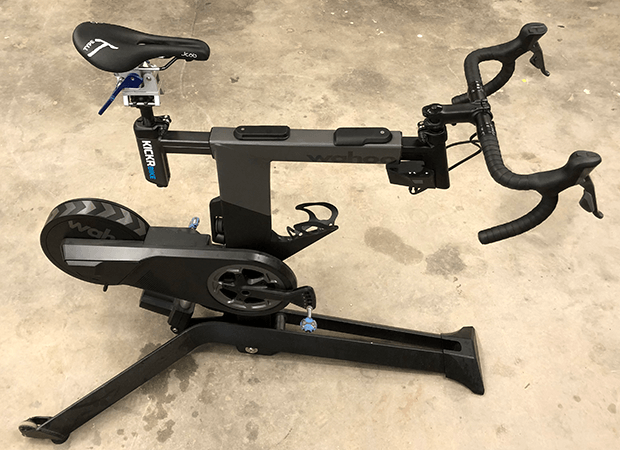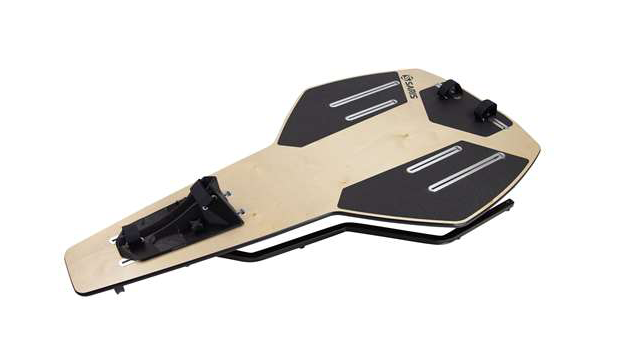Smart Bike Shootout
Today I’m comparing what, thus far in these early months, are the two giant products of 2020: The Tacx NEO Bike and the Wahoo KICKR Bike. The ordering of this shootout is a little backwards because I’ve written my long-term review of the KICKR Bike, but not yet of the NEO Bike. Nevertheless, I know enough about both bikes to compare them. Of the NEO Bike I’ll write in more detail later.
In most other years these two items might not be the finalists for product of the year. But if there is something this year that eclipses toilet paper as the preeminent need in my household, it’s one of these bikes. I can’t speak for what the Average Joe considers more important but, as for myself, a smart bike and a garden hose and I’m good.
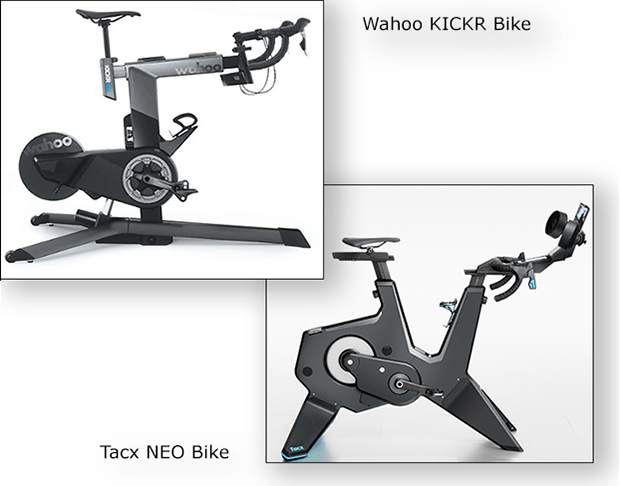
I’m not including the Wattbike or the Stages bike or the Peloton or any other bike in this shootout, because I don’t have those bikes. I will write about those bikes. (Well, some of them.) The KICKR and NEO bikes are extrapolations each company's premier smart trainer unit, each of which is world leading, and that’s why I’ve started with this particular pair of smart bikes.
Why a Smart Bike?
You might ask why a smart bike at all? We live in the most economically perilous time of my life (and I was born in the 50s, so I’ve lived through a few). One reason is because we’re housebound, and you’re going to drive yourself and those around you crazy unless you can find something with which to occupy yourself.
But let me answer this is in technical terms. There are 2 reasons a bike like this towers over a smart trainer alone for stationary use: 1) Customizable gearing, the capacity to change that gearing, and shifting that never fails; 2) Instant adjustments, in any plane, handlebars and saddle, usually possible during a ride.
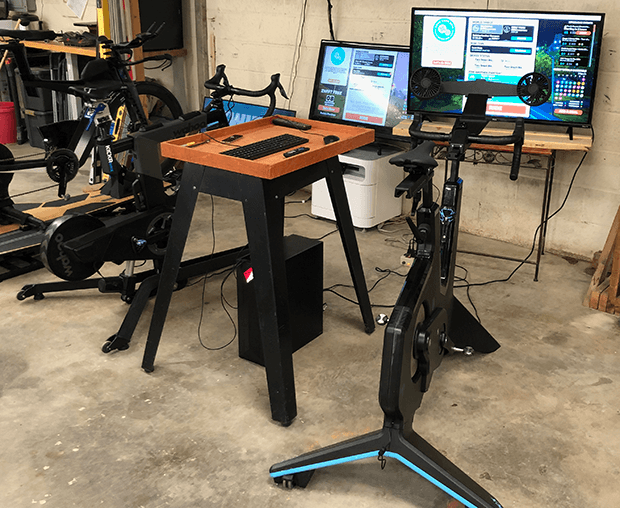
The first thing is really neat. Really neat. The second thing is beyond neat. In years past I’ve written about a luxury I have that others don’t: Because we have a bike fit school on The Compound I have a studio full of easily adjustable fit bikes. For the past 20 years this studio has known better and better fit bikes, and privately, selfishly, as I ride my stationary workouts aboard these fit bikes, I get to make alterations in my fit coordinates during these rides. I dial in my coordinates as I ride. Instant feedback. Now, with a bike like this, you get to enjoy that too.
Let’s talk these bikes across a half-dozen or so major categories, and I’ve listed what bike I think “wins” each category.
Display & Configuration
Ease of Configuration: I configured each of these bikes through an app on a handheld device. My handheld is an iPhone, and on the screenshot below you can see the two apps I used. This can be confusing to someone in my age bracket, when there are multiple Tacx and Wahoo apps. In the case of Wahoo, no, it’s not the ELEMNT app, and it’s not the Tacx Training app, nor the Garmin Connect app. You may well use these other Garmin/Tacx apps when you ride on the Tacx bike, but the Tacx Utility app is what you use when you set these bikes up (settling on your gearing, for example.) Both bikes apps worked fine. I guess I’d give the slight edge here to Wahoo, and maybe it’s me, but sometimes (and in this case) I don’t seem to get things to pair right away with Garmin/Tacx, or the apps aren’t quite as intuitive as they could be. But this is a “soft” plus to Wahoo. Both worked fine.
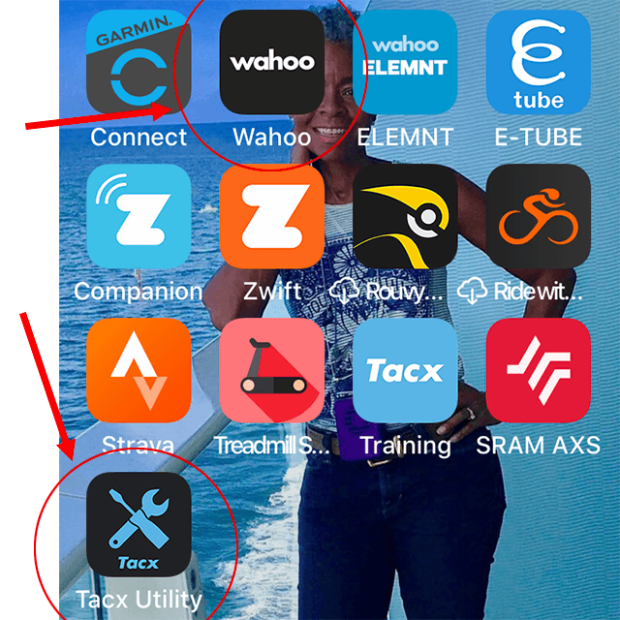
Gear display: Each of these bikes lets you visually know what gear you’re in. Why? Because if you’re on your bike on a trainer, you can look down to see what gear you’re in. Not so here, because the gearing is virtual. There are no actual gears on either of these bikes. And I promise you, as you’re on a 9 percent grade in Zwift, approaching what will become a 16 percent grade, you will look down to see how many more cogs you have left. Hence the gear display.
In this case I give the soft-plus to Tacx, because when I’m riding hard all the blood leaves my brain and goes to my legs and I can’t do 54 divided by 9. (Mind, the older I get the harder that gets, on the bike or off.) When you’re riding hard, and Wahoo tells you that you’re in 1 and 9, what was 1 again? Big ring or small? And, is that the 9th hardest or easiest gear? The longer you ride the KICKR Bike the more you come to recognize and remember that the lower number is always the easiest gear. So, 1 and 9 is the small chain ring and the 9th easiest gear. When you’re on that 9 percent grade and you see a 1 and 4 you know you’re in the small ring and you have 3 more cogs left before you’re out of gear.
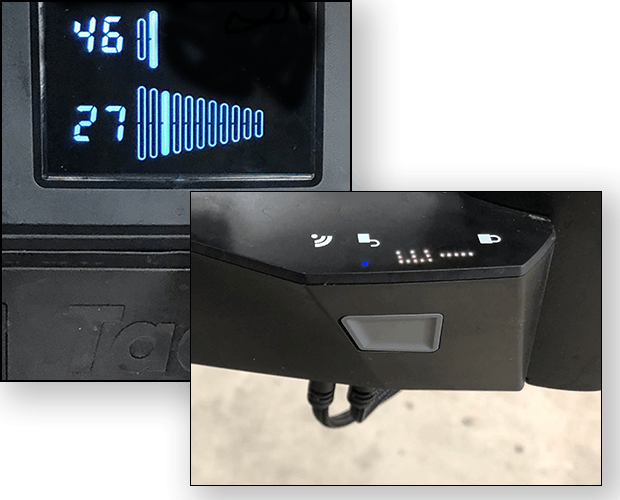
Visibility of screen: This is another soft-plus to Tacx, and you might thing I’m discussing the same feature as I just discussed above. I’m parsing between the ease of seeing the screen, here, with the ease of understanding what the screen is communicating, above. The Tacx screen is right there, no missing it, easy to see. The Tacx bike’s front display, and its fans, may present an obstruction to a big screen in certain configs and I’ll talk about that below.
Can Take Aerobars: Both these bikes accept aerobars. No issue here. The one minus to these smart bikes is that I can’t imagine any method by which you can shift at the bar-ends. I hope someone will correct me if I’m wrong about this. This is pass/fail, both bikes pass, neither bike wins this.
Shifting
Shifter Ergonomics: How comfortable are the shifters? And I mean, the hoods, the hood shape. I have zero problem with either. They’re both very comfortable. Different, but comfortable. I truly do not have a preference. I guess maybe I’d give a slight nod to the shifters on the NEO Bike, which are really comfortable! But that nod is at the expense of some other imperatives, which are listed below. Soft-plus to Tacx.
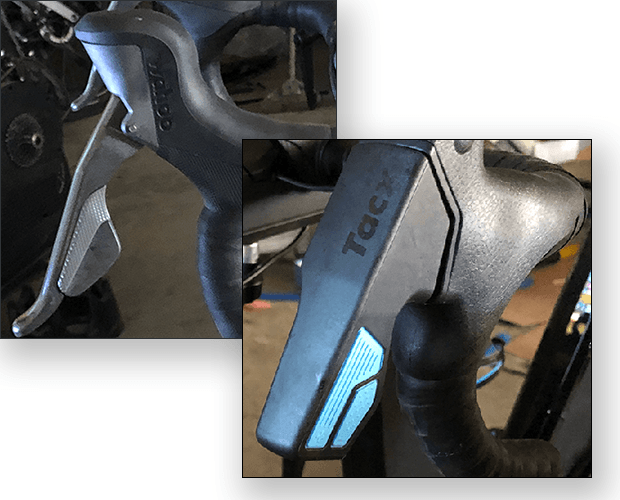
Shift Intuitiveness: The NEO display is more obvious than the KICKR display, per what I wrote above. Conversely, the KICKR shifting – what your hands do – is more obvious than the NEO shifting. There are 2 shift paddles on the KICKR Bike’s levers, mimicking Shimano. You can set them up, in the Wahoo app, to act like Shimano shifters, or like SRAM shifters. Because SRAM has only 1 paddle on its levers, both paddles on a shifter perform the same function. You can pretty much configure the shifters to work however you want. This is a medium-big deal. (I posted some screenshots below that shows some of the set-up process in the Wahoo iPhone app.) The NEO's shifting buttons are fine. The left buttons shift the FD, the right shift the RD. They're fine. Just, not quite as intuitive. Plus to Wahoo.
Shift Mimics Road Riding: I wrote above that the NEO's shifters might be slightly more comfortable than the KICKR’s shifters, and if so, it’s not by much. Both are quite comfortable. But remember, Tacx is making a shifter for a stationary bike. If you hit a bump on a descent on the NEO Bike you aren’t going to do a keester-over-teakettle faceplant on the road. Shimano and SRAM have to take that into consideration when they design shifters. If you ride a KICKR bike you’re riding a true, road style shifter. Is that important to you? Soft-plus to Wahoo.
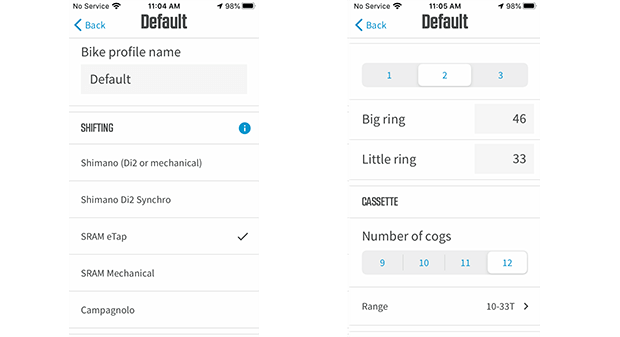
Adjustability
Range of Adjustability: Both are highly adjustable. The adjustment scheme on the Tacx is more straightforward. The Wahoo has taken pains to be a more x/y bike than the Tacx, and a more compact bike. I note that. This allows the bike to be a little lighter, which the Wahoo bike is. But, both bikes are about equal in their range of adjustment. They won’t fit everyone. I calculated that the Tacx bike’s saddle, BB to saddle-top, goes down to about 63.5cm, and that’s with the saddle that comes with the bike, which has a rails-to-top dimension of 45mm. If you put a lower profile saddle on there, like a Specialized Romin, that has a 30mm height profile, you could get down to about 62cm. The KICKR Bike likewise gets the saddle down to about 62cm or 63cm of height.

Both bikes will accommodate tall riders as well. At least in terms of saddle height. The KICKR Bike will get you a saddle height of about 88cm, the Tacx NEO to 93cm. I’m 6’2” and my road bike saddle height is 76cm. If I were a leggy 6’2” it might be 80cm. So you see, no issue there. Oddly, though, both bikes suffer from a lack of handlebar length that corresponds to saddles that can go up that high. HX is the raw horizontal length from bottom bracket to the handlebar clamp (where the handlebar passes through the stem). In each case, the bikes struggle when you get past an HX of 50cm. I ride with an HX of 50cm, so, I’d be at my limit, except I ride with a shorter reach handlebar that the bar each of these bikes come with, so, I have some wiggle room.
Just know that if you ride with a “long and low” road position, and you’re over 6 feet tall, you begin to run into adjustment issues with both bikes in this particular metric: handlebar length (i.e., “frame reach”, i.e., top tube length). Both bikes are, in all other cases, highly adjustable as per the typical contact points. The Wahoo bike uses a standard stem, so, beyond all the other adjustment options, if you found you maxed that bike out, lengthwise, in either direction, you could also change the stem.
Adjustability on the fly: As noted in my intro to this, one of the two major advantages to these bikes is the capacity to adjust them easily, so that you and I can fiddle with our positions. Best is when you can adjust the bike while you’re on the bike. While riding. In the middle of a ride. I’ve made on-the-fly adjustments while riding with both bikes.
The NEO Bike gives you two options for adjustment of its major coordinates: saddle height and fore/aft, and handlebar height and fore/aft. You can use a set screw, or you can replace a set screw with a handle. Do the latter. Use the handles. If you do, then the NEO Bike is just a tad more easily adjustable on-the-fly than the KICKR Bike. Both bikes' adjustment schemes are in the image above. In that image, see how on the KICKR bike you turn in-line handles 90 degrees, which releases pressure on the telescoping tubes, allowing you to move those tubes in and out. Mind, the KICKR Bike is quite adjustable. But the telescoping features, like the extendable front end, is a little sticky when you try to do this on-the-fly. It can be done. Just, the NEO Bike is a little easier to wrangle. Plus to Tacx.
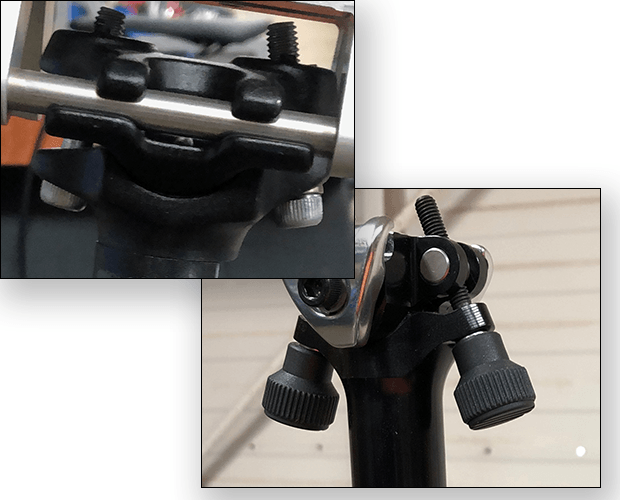
Saddle tilt adjustment: Both bikes make it easy to adjust saddle tilt. In neither case can this adjustment be made on-the-fly. Both these brands missed an opportunity here, in my view. However, in each case the bikes are subject to eventual retrofit. Note-to-bike-makers: the more you fart around with a 4mm or 5mm Allen bolt, the sooner that Allen bolt head rounds. The more you fart around with a T20 Torx bolt (as the NEO uses) the sooner that Torx bolt will round. Best to use other methods when possible. Above is the KICKR Bike’s seat post hardware, typical hardware, and next to it the Purely Custom Fit Bike’s seat post hardware. They work identically. If you replace the Allen bolts with thumb screws, you can adjust saddle tile on-the-fly, as you're in the middle of a ride.

Adjustable Cranks: I’m an inventor-manufacturer in a former life, and the first rule among people who do what I did is: Don’t invent what you can more easily "appropriate". I’ve used every kind of adjustable crank there is, mostly in the context of adjustable fit bikes. Wahoo appropriated what I believe remains the easiest, cleanest adjustable crank, designed by Jeff Keller of Sunrise Cyclery 2 decades ago (inset into the picture above of the Wahoo KICKR crank. You just have a bunch of holes in a crank arm. Choose, in 2.5mm increments down to 165mm.
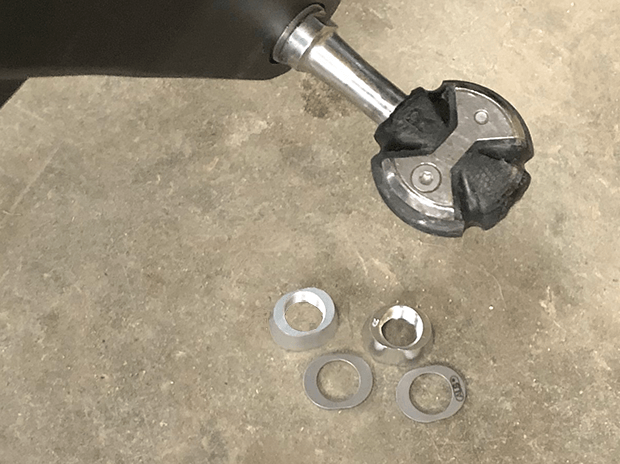
The NEO Bike has inserts, each of which corresponds to a crank length. The NEO Bike’s method gives you a cleaner looking crankarm, but the problem is that you have to keep track of the parts you don’t use (such as the parts in the image above). The NEO Bike is also adjustable from 170mm to 172.5mm to 175mm, not down to 165mm. Plus to Wahoo.
Road Feel
Smoothness: Both bikes are at the top-of-the-heap when it comes to ride feel. Each of these smart bikes is better than other smart trainers in a number of categories, and ride feel is among them. They're each superior to anything else I've ridden in shifting, in coasting, and both bikes maintain speed during Zwift descents. The NEO Bike can sometimes get ahead of my pedaling, so that I have that load-free spot as my pedaling catches up (if I’m not pedaling well). I hate that. But, I hate that in me, not in the bike. The NEO bike precisely replicates when I’m pedaling badly.
Maybe the NEO Bike is slightly smoother than the KICKR Bike. It’s hard for me to pick a winner here. They're both just so much better than anything else.
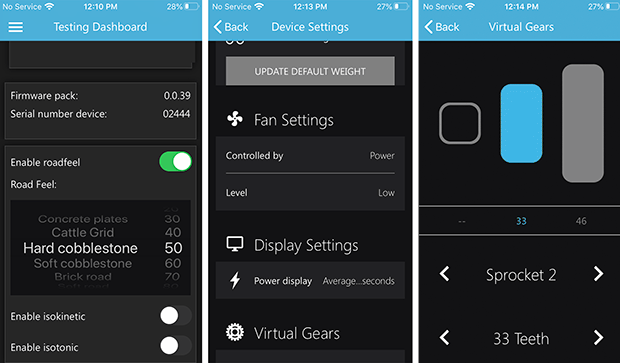
Road Surface Feel: This is one of these categories where you either have it or you don’t and NEO Bike has it. If you look at this display, above in the right hand screenshot, of road surface features, and how Tacx handles this, you not only get road feel, and you not only get road feel broken down into various road features, you get to choose how ardently you feel each feature. Tacx is rubbing it in here. It knows it has something no other trainer has – whether the NEO standalone trainer or the NEO Bike – and it’s accentuating the lead it’s got on the other smart trainer makers. I would do the same thing. Just keep coming back to what you do best, and pound it home. This feature works on Tacx Films, Tacx Training software and Zwift (I'm awaiting a list of other platforms on which this feature works). Plus to Tacx.
Pitch Change: And here is the KICKR Bike’s big feature not matched by other trainers. As the road pitches up in Zwift. The bike pitches up. Ooh baby. And on descents, it pitches down. Whether this is a big deal to you depends on whether climbing on a bike is a major tenet of your religion, as it is with me. The value of this can’t be understated, if you’re me. But you’re not me. This incline/decline platform sync works with Zwift, Rouvy, RGT, PerfPro, Kinomap, VirtuGo, FulGaz and others. (Please excuse my swiping the screenshot below from Wahoo’s site, but I couldn’t figure out a better way to demonstrate this.) Plus to Wahoo.
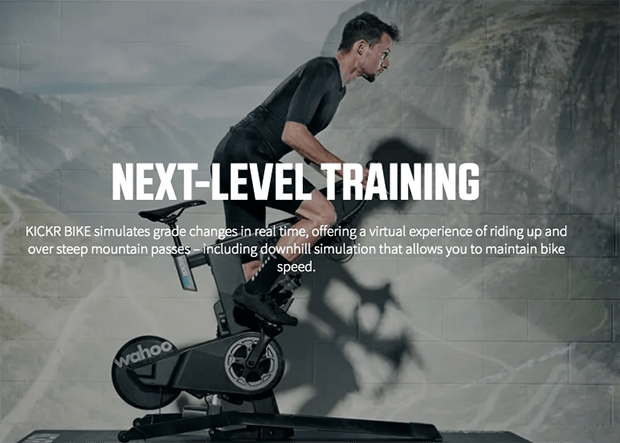
Other Stuff
Solidity versus Ease of Relocation: The Neo Bike weighs 110lb, the KICKR Bike 93lb. The KICKR Bike, though it’s not much lighter, feels much lighter when you move it around the room, or from room to room. (Both bikes have wheels on their back legs, and roll around like wheelbarrows.) The NEO feels a little more solid, and that’s no doubt due to its extra weight. It’s about the same size as my (woodworking) router, and in the case of the NEO Bike and my router the impression you get when you try to move it is, “Geez, this thing is a lot heavier than it looks.” In the case of this kind of bike, I find that heavier is better.
The KICKR Bike and the NEO Bike each have adjustable feet, though there’s a pedestal right under the bottom bracket that is the KICKR Bike’s first point of contact, and if you don’t adjust the feet out a bit the bike won’t sit squarely on these feet. This partly limits the capacity of those feet to stabilize the bike on an uneven surface.
Both Bikes are easily enough transportable (though the KICKR slightly more easy); and both bikes are plenty stable (though the NEO is the one you’d say is rock solid).
Prognosis for Additional Features: As I wrote in my review of the KICKR Bike, there are more buttons on the shifters than there are things for those buttons to do. Which is intriguing, because, what does Wahoo have in mind? Those guys’ brains are never fallow. If Garmin (which owns Tacx now) has a strength, it’s in coming out with a product that is so good that you just say, “Nailed it!” And you wonder how anyone could ever compete. Wahoo’s strength is in producing a platform – a “host” if I can use a Westworld term – and it just keeps tweaking the narrative through firmware upgrades. I wonder how Wahoo might tweak the narrative with the extra shifter buttons. So, I’ll give a soft-plus to Wahoo here, only because of a bunch of buttons that aren’t used.
Fans: Tacx has fans. Now, you might say so what, because I already have fans. But these fans are strategically placed and because they increase or decrease their RPMs based on either how hard you work, how fast you go, you can turn them on and off, adjust their direction as you’re riding, and until you have fans like this you shouldn’t pooh-pooh their existence. That said, I alluded to a possible obstruction issue with the NEO Bike. It has been my experience that when I ride a tri bike on the trainer I have to put the TV screen well below where I’d put that TV if my road bike is on the trainer. As in, the TV is almost on the floor, angled up toward my line of sight. If this describes you, you will or won’t need to remove the fans (which are made to be removed if you don’t want them), depending on how low you need the TV; where your aerobars sit in relation to the front end of the NEO Bike; and how far your TV is in front of your bike.
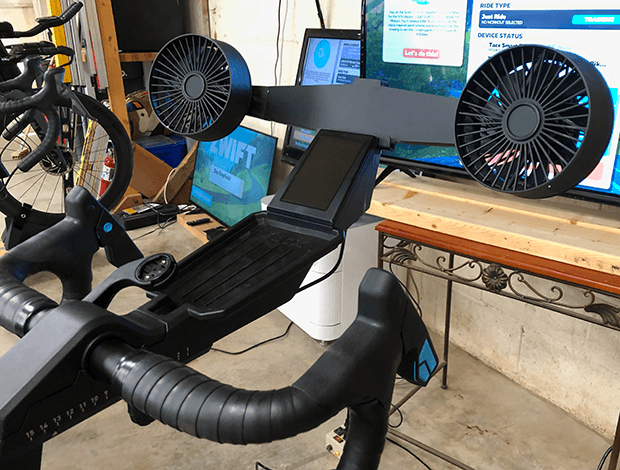
Noise: Both bikes are quiet. The NEO is quieter. You… can… not… hear it if you’re in the next room. The KICKR Bike’s noise output is, to me, perfectly fine. Plus to Tacx.
USB Chargers: This is kind of cool. The NEO Bike has a pair of these. Just like in your car. You might think, well, shoot, I have all sorts of places I can charge my devices. But if you need your iPhone’s Zwift Companion App during a Zwift ride, and your iPhone is just about out of juice, there you go.
Price: The KICKR Bike sells for $3,500 and the NEO Bike for $3,200. They’re close enough so that I can only give a slight nod to the NEO. Soft-plus to Tacx.
Accuracy: I have not found one whit of difference, so far, in the accuracy or precision of these units. I’m going to make a more careful study of this for future publication.
The Upshot
I cannot declare a winner, because the features are too much tied to what you personally need. It could come down to crank length. If you absolutely must ride with a 165mm crank, it’s the KICKR Bike. If it’s road feel, it’s the NEO Bike. Incline? KICKR Bike. Road sprints a big thing to you? The NEO Bike is a tank, and might handle those a little better depending on how much power you produce and how much you torque the bike.
My takeaway is this. These are the best and second best (one way or the other) trainers I’ve ever ridden and the third best is a long way behind. I haven’t ridden other smart bikes. The best smart bike would be the GURU fit bike, at $18,000, only if it had a NEO or KICKR or similar resistance unit. But it doesn’t. Which brings us back to these bikes as, far and away, the best stationary experiences of my life. The only combo arguably in the conversation is a smart trainer aboard a Saris MP1 platform, and I’ll cover that elsewhere.
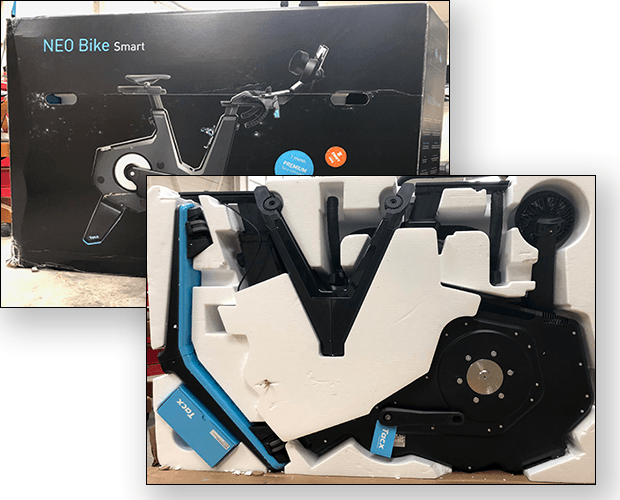
One last thing about ownership, and purchase pathways. I got the KICKR Bike already assembled. The NEO Bike was shipped to me. I can’t speak to how the KICKR Bike is packed. I’m sure it’s fine, but, I haven’t seen it. I have seen how the NEO Bike is packed, and I cannot imagine what a Fedex driver would have to do to damage it. (Above is the box, and when you take the side panel off the box you get this large block of styrofoam with the NEO Bike inside.)
I own neither of these bikes, and it’s not easy for either you or I to get one. I’m reading at My Bike Shop that it looks like April for a NEO Bike, so, next week or next month depending on when in April, and next week on a KICKR Bike. Clever Training same thing as of today’s writing. All the retailers I'm looking at appear to have both these bikes available in April. Read more about the Wahoo KICKR Bike here, and the Tacx NEO Bike here.


